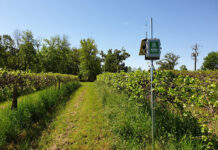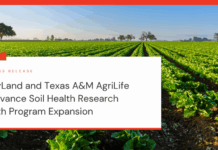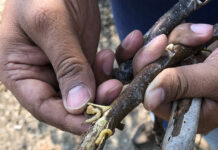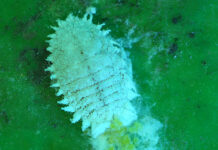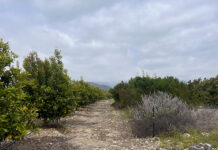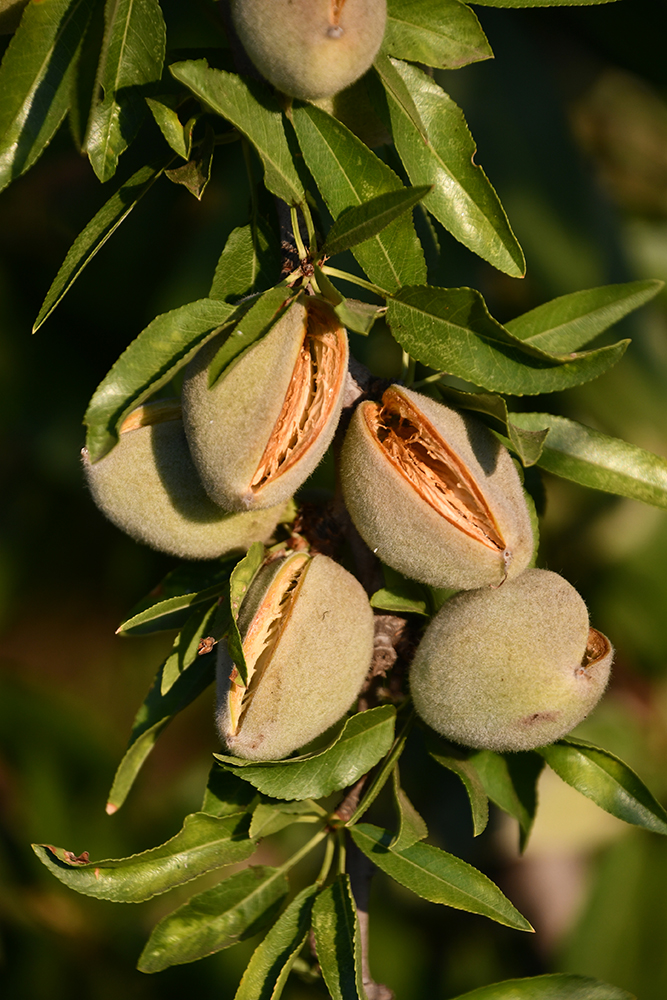
From the standpoint of navel orangeworm (NOW) management in almonds, hullsplit is the most critical fruit developmental stage. Almond fruits open at their suture during this period and become susceptible to NOW infestation. If the beginning of Nonpareil hullsplit coincides with egg laying time of the second flight of NOW, the risk of NOW damage increases. Therefore, understanding NOW activity and hullsplit status is vital for timely insecticide applications. The nuts on the southwest side of the canopy mature earlier, so the initiation of hullsplit in a block should be confirmed by regularly checking on the southwest side of the canopy. An orchard ladder or pruning tower can aid in reaching the fruits from the top of the representative trees to detect early split. Also, knowing the difference between true hullsplit and blank nut split is essential because blank nut hullsplit usually begins one to two weeks before the sound nut hullsplit begins. Nuts in edge trees, especially on the southern edge of an orchard, often start to split several days to a week ahead of trees within the orchard. Edge and blank splits signal the approach of hull split of sound nuts inside the orchard. Hullsplit timing varies among tree water status, varieties, geographic regions and weather conditions; however, prediction models are available to predict hullsplit timing for various locations. Research and field experience tell us that spraying earlier, rather than later, is the most effective strategy for reducing NOW damage.
NOW Traps and Spray Decision
NOW monitoring (egg, male and female) traps do not provide a specific treatment threshold; however, they can be highly beneficial for spray decision-making since they inform the grower about seasonal pest activities. Egg traps are helpful to set the egg-laying biofix for overwintering adults in the spring and track the heat units to determine the completion of that generation and the beginning of the second generation (i.e., 1050 degree-days). The second generation infests the early hullsplit nuts, and the timing for that generation is critically important to minimize the nut damage. The utility of egg traps for guiding spray timing would be less clear for the later generations because of the continuation of egg-laying due to overlapping adults among generations. However, the density of egg laying in egg traps and female moth activity (in Peterson traps or similar tools) are good indicators of potential NOW pressure and, possibly, nut damage.
Experience shows that unless an orchard is in an isolated location with a history of very low NOW damage and low NOW population, most almond orchards in the Northern Sacramento Valley warrant at least one spray at hullsplit. However, missing proper spray timing and not practicing other cultural practices such as winter sanitation may result in higher-than-acceptable levels of nut damage. Therefore, minimizing NOW damage requires practicing cultural techniques, such as winter sanitation and timely harvest, monitoring pest populations and making well-timed insecticide sprays. Once hulsplit begins and eggs are being laid in egg traps, spray to protect early hullsplit, watch traps tracking females (egg and/or Peterson traps) and check early split nuts for worms to make preharvest spray decisions and decide on harvest timing. If NOW pressure is high, it might be worth a talk with the processor to look at timely harvest and kernel (meats) production vs later harvest for inshell. If NOW pressure is high, damage can increase very rapidly, and every day the nuts are in the trees increases the danger of further damage.
Determining Spray Timing and Numbers
The number and timing of hullsplit sprays depend on orchard history, in-season pest monitoring information, use of other cultural practices such as winter sanitation and timely harvest, and overall risk of NOW immigration to the orchard. Typically, the first hullsplit spray for NOW is made when the eggs are being laid and the hullsplit begins. Commonly used, relatively reduced-risk insecticides only kill eggs and larvae. Some are effective against adults; however, insecticides must contact adults to be effective. Spraying during the night or early morning is more effective than spraying during the day. These insecticides can be effective for two to four weeks; a second application may be necessary if you continuously find high numbers of eggs, females and males in their respective traps and you cannot harvest the nuts before the third flight activity. Early hullsplit pollinizers split about two weeks after Nonpareil; the hullsplit typically starts when the NOW third flight begins. For many growers requiring a second hullsplit spray, a second application can help both Nonpareil and pollinizers. Late-season pollinizer varieties can be at risk from the latter portion of the third and fourth flights if not harvested on time.
Additional Considerations
Provide good spray coverage. Good spray coverage is essential for effective NOW control. Many years of study have indicated spray coverage is the function of tree height, sprayer speed and spray volume. In mature almond orchards, it has been shown that high-volume spray (150 to 200 GPA ) with a slower spraying speed (2 mph) provides better coverage and NOW control, though it is an unconventional practice for many growers.
Harvest on time. The goal of timely harvest is to get the almond harvested once 100% hull split occurs for all varieties, and if possible, before the beginning of the third generation for Nonpareil and before the fourth generation for other late varieties. Ensuring that nuts are at the proper maturity stage during the harvest is critical. Too early harvest can lead to mold development and chipping issues during the processing, reducing the nut quality.
Know your insecticides. Insecticides differ in their mode of action, efficacies to NOW and toxicity to beneficials (Table 1). Knowing those facts can help select the best insecticide for a particular situation. Most of the insecticides labeled for NOW target newly hatched larvae and have some impacts on eggs. Some have effects on all stages. Insecticides applied for NOW management at hullsplit must kill the egg or larva before feeding damage occurs. Another difference among NOW insecticide is their potential effects on spider mite predators such as predatory mites and sixspotted thrips. Non-selective insecticides, in general, are more toxic to those beneficial than selective insecticides. Therefore, the tradeoff of using broad-spectrum insecticide should always be considered.

Understand seasonal changes in NOW biology and behavior. NOW development rate changes during the season. The first and second generation of NOW needs about 1050 degree-days to complete one generation. However, after that, NOW can complete a generation in only 750 degree-days due to better nutritional quality offered by the fresh nuts. Temperature plays a significant role, too, as higher temperatures during the summer accelerate egg hatching and larvae development.





